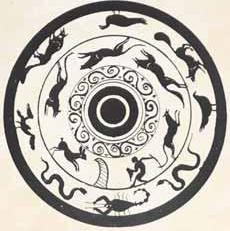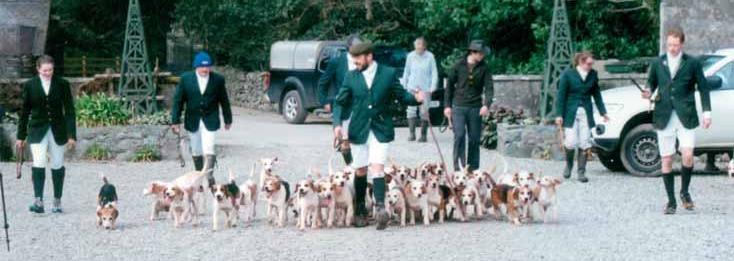
10 minute read
An Ancient & Proud History of Hunting with Hounds - By Derek Fanning
The ancient and proud history of hunting with hounds
The practice of hunting wild mammals with dogs has been with us in Ireland for an incredibly long time. No one has an idea exactly how old the practice is but it could be several thousand years old. It's almost certain that our prehistoric ancestors engaged in the activity. Therefore when you head out in the fields and woods to hunt foxes or hares you are part of an extremely ancient tradition.
Advertisement
Some people are under the mistaken illusion that hunting with dogs is a tradition introduced by the British a few centuries ago. The activity is much older and it's completely wrong to associate it with the British because it in fact transcends national identity. Hunting is an instinct innate in each of us regardless of our race, nationality, gender or creed.
The famous zoologist Desmond Morris points out that for about a million years our ancestors roamed the Earth, in small groups, hunting and gathering. You cannot erase a million years of hunting by wishful thinking or fashionable ideology, because it's hardwired into our psyches and, according to Morris, is connected to our feelings of happiness. The moments in our lives when we achieve something hard-won and punch the air in triumph is related, he says, to the moment when our ancestors caught and killed their prey. Our hunter-gatherer forebears spent much of their time and energy engaged in the chase. Thankfully we no longer have to devote so much time and energy to the pursuit of food but the instinct is still very powerful in us.
We of course do not know when these hunter-gatherers started using dogs to assist them in their hunting. It's estimated that it could be about 20,000 years ago. Agriculture began about 10,000 years ago and with the passage of time hunting increasingly became a sport rather than a matter of survival. Cave paintings which are 6,000 years old show pointers, shepherds, mastiffs, greyhounds, and wolf breeds.
At the turn of the 20th Century, Lady Gregory went through a lot of manuscripts featuring Irish myths and married them expertly in her excellent book "Gods and Fighting Men". In this book Fionn Mac Cumhail and the Fianna engage in an awful lot of hunting and there are many references to hunting with hounds. The Fianna are lovers of music and poetry as well as the chase (for example, there is reference to a woman harper called Fethnaid who is one of the Tuatha de Danaan and plays music which is "the delight of their minds".) The manuscripts which Lady Gregory used date back to the 9th Century, which shows that hunting with hounds was a very popular activity in Ireland as far back as this at least.
Many people think the Fianna (or their equivalent) hunted with wolfhounds. In fact this is not so. Archaeologists have found no dogs of Irish Wolfhound size at Irish sites from


In Ancient Greece hounds were used not to catch the hare, but to drive it towards nets and a hidden huntsman, a practice which was perhaps familiar to the ancient Celts. This illustration appears on a phial in the British Museum.

Early medieval manuscripts created in monasteries often feature depictions of hunting dogs, which look similar to Celtic Hounds, or sight hounds like the contemporary Galgo Español which is believed to be descended from the Celtic Hound.
1000 BC through to 1200AD. The dog bones which they have found indicate that the hounds of the Fianna would have been no larger than an Alsatian. Scholars refer to them as "Celtic Hounds" and point out that related contemporary breeds include the Galgo Español or the Tyrolean Hound. When you look at photographs of the Tyrolean Hound you will see a scent hound which reminds one of a beagle or a harrier. Tyrolean Hounds can be used to hunt hares and foxes. The Galgo Español looks like a greyhound and is a sight hound (which is often used to hunt hares).
Hounds were strongly valued in the Celtic world
In one of the countless hunting stories in "Gods and Fighting Men", Arthur, son of the King of Britain comes over to hunt with the Fianna. He's so impressed with three of the Fianna's hunting dogs that he steals them and brings them back to Britain. Fionn follows him and after a fight gets back his hounds. There are other tales of hounds being stolen in the book which perhaps indicates that they were strongly valued in the Celtic world and their theft was reasonably commonplace. On one occasion a "woman-Druid" falls in love with Fionn but he rejects her (so long as there was another woman to be found in the world, he says, he would not marry a witch). She gets revenge by stealing 150 of his dogs which he never gets back. The strong emotional bond between dog and human is touched upon in the book. A famous hound called Adhnuall "gave three loud howls" above the graves of fallen Fianna warriors, "stretched himself out and died.”
Fionn likes to head-count his dogs after a hunt, something which contemporary huntsmen still do: "And as to the Fianna, after their hunting was done they gathered together on the hill; and as the custom was, all Finn's hounds were counted. Three hundred full-grown hounds he had, and two hundred whelps; and it is what the poets used to say, that to be counting them was like counting the branches on a tree.”
On the day of a hunt on the plains of Magh Chonaill, three witches lure the Fianna into their cave where a spell is cast upon the warriors and they are tied up. The hounds are left outside the cave and they protest at being separated from their masters. "And there began at the mouth of the cave a great outcry of hounds calling for their masters that had left them there. And there was lying on the hillside a great heap of deer, and wild pigs, and hares, and badgers, dead and torn, that were brought as far as that by the hunters that were tied up now in the cave."
In the ancient world the Celtic Hound was much sought after by the Romans who, it is thought, probably favoured the Galego type sight hound. The Irish Celts of the time, it is believed, liked to use their scenting hounds to find the quarry and push it out to a point where sighting hounds could be released to course it. It's also theorised that some ancient Irish chieftains would have considered hunting to be a good training

There is a huge body of art and literature based on the hunt including this 1833 painting of Delme Radcliffe and his harriers.


The Beecher family of Duhallow at Ballygiblin c.1895. Many people associate hunting with hounds with landed gentry, the wealthy and the British. The story is much more complex than that. ground for their warriors (an idea which continued until relatively recently when cavalry officers encouraged their subordinates to go fox hunting on horseback as it would give them "an eye for the country”.)
There are many hunting scenes carved in stone at various religious sites. On the 9th Century Bealin Cross in Westmeath there's a dramatic depiction of a hound seizing a deer followed by its master with a spear. There's a hunting mural in Holy Cross Abbey in Tipperary, and on the tomb of the Earl and Countess of Ormond in St Canice's Cathedral, Kilkenny. The Market Cross in Kells has a hunting scene. The deer or stag is usually the hunted animal in the earlier sites; the quarry species changes with the passage of time. During a period of the Middle Ages the hare was considered the most desirable of the quarry species, for people on foot as well as mounted followers.

When the Normans arrived in the 12th Century the hunting method they preferred was the French fashion of using scenting hounds; and they


Sunnyland Beagles (Photo: Tom Fulton) preferred hunting fox and hare rather than deer because the latter, being the Red Deer, was large, agile and very quick and therefore a difficult quarry. A fast hound was needed for red deer, the idea being to flush them out into open country. A 1244 mandate to John Stronge, Justiciary of Chester, required him to provide 80 fallow deer from the King's Parks in England for shipment to Dalkey from where they were to be taken to the King's Park of Glencree. The fallow deer was seen as a more suitable quarry for hunting with a pack of scenting hounds and their introduction to Ireland was for that sole purpose. We also hear of the Abbot of St Mary's Abbey in Dublin being accused of using illegal methods of hunting, including nets, in the Royal Forest of Glencree. St Mary's was one of many abbeys which had hunting rights. Many Anglo-Norman nobles also appear to have had their own hunting forests. These nobles usually kept packs bred for scent and voice rather than pace.
The form and customs of hare and fox hunting as we know them today date back to the first half of the 18th Century. The Duhallow Hunt in County Cork dates back to 1745 and is generally regarded as Ireland's oldest foxhound pack. The Scarteen pack in Limerick is older, dating back to the early 1700s (possibly as far back as 1691, according to Stanislaus Lynch) but it consists of Kerry Beagles therefore, strictly speaking, it's not a foxhound pack. It's believed the Duhallows in fact were in existence before 1745 but there is no recorded history. As the 18th and 19th Centuries progressed the sport became increasingly popular throughout Ireland. Foot harrier packs also made an appearance, which hunted hare, and were popular with people of lesser means. Today hunting with hounds is still widely practised and enjoyed by many people throughout Ireland.
In rural communities hunting with hounds is a very important social outlet for a lot of people who look forward to their day out as a highlight of their week. Lasting friendships are often formed. Love blossoms, with marriage sometimes being the outcome. When so much has been taken from rural communities and rural communities feel under so much pressure and threat, hunting represents the continuity of an ancient tradition; it represents the resilience of much-cherished tradition in the face of sweeping and rapid change. Hunting is also a not unimportant economic activity, with practitioners parting with quite a bit of cash during their activity, including paying for equipment, accommodation and food.
Nowadays, hunting with hounds is controversial and is under considerable ideological threat. Those attacking the pastime unfortunately don't practise the decent attitude of live and let live. Instead, they condemn without adequate knowledge and insist on imposing their beliefs on others. Faced with this ideological onslaught the attitude of many hound followers is the very understandable one of keeping their heads down while keeping on hunting. They want to fly below the radar as much as possible and keep away from others' censure. This is a sad state of affairs for a pastime which has such an ancient and proud history. Hunting should be a badge of honour not a badge of shame.












